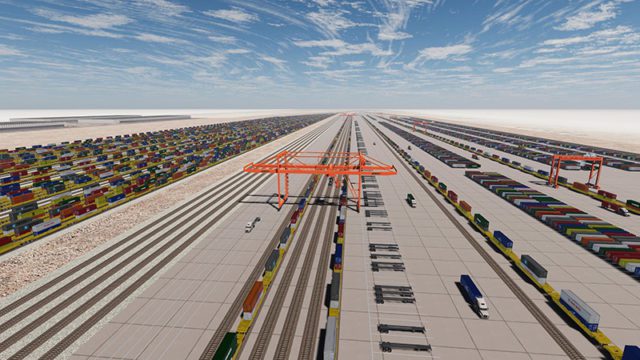
CHICAGO — BNSF Railway would have to reconsider its plans to build the $1.5 billion Barstow International Gateway if California’s zero-emissions locomotive mandate is allowed to move forward, CEO Katie Farmer says.
The California Air Resources Board’s in-use locomotive rule went into effect on Jan. 1. It bans the operation of any locomotive that is 23 years old or older from operating in the state. And it requires switching, industrial, and passenger locomotives to be zero-emissions by 2030 and freight line-haul locomotives to be emissions-free by 2035.
CARB has asked the U.S. Environmental Protection Agency for a waiver that would allow full implementation of the rule, including a provision that would require railroads to contribute to a spending account annually that would set aside money for the purchase of zero-emissions locomotives.

“We estimate that that payment for us, and I know that it would be similar for the Union Pacific, would be around $800 million a year,” Farmer told the North American Rail Shippers conference last week.
The rule has a number of problems, Farmer says. Chief among them: A commercially viable zero-emissions locomotive doesn’t yet exist. The rule, which initially would bar two-thirds of the locomotive fleet from operating in California, also doesn’t recognize the complexity of the interstate rail network. The spending account provision would drive up rail costs and ultimately push freight to trucks that emit far more greenhouse gas emissions.
“If CARB receives a waiver from the EPA to implement this in 2026, I promise you … 17 or 18 other states are going to follow suit and we are going to see a tax on movement of goods through the U.S. supply chain,” Farmer says. “That will have a devastating impact on the competitiveness of the U.S. supply chain.”

Because the rule would put railroads at a competitive disadvantage in California, BNSF would have to reconsider plans to build its massive terminal in Barstow, Farmer says.
The railroad has acquired all 4,500 acres of property for the terminal and is beginning the permitting process in Barstow, which backs the project that will create as many as 20,000 direct and indirect jobs in the longtime rail hub. BNSF’s main lines from the Los Angeles Basin and Northern California converge at Barstow, a key point on the railway’s Southern Transcon.
BIG will include a block-swap yard, support yard, and warehouses and transload centers where goods in international containers can be transferred to domestic containers for the eastbound trip to inland markets via rail. The idea behind BIG is that it will ease congestion at the ports of Los Angeles and Long Beach and eliminate the 80-mile dray moves for freight that’s currently trucked from the ports to the Inland Empire for transloading before being trucked to one of BNSF’s intermodal terminals for the trip east.
If CARB gets EPA’s blessing and survives a court challenge from railroads, BNSF would “absolutely re-evaluate our investment in California,” Farmer says.














The Pennsylvania, Milwaukee Road, Virginian, and several other long-gone roads had figured out the solution to zero-emissions freight: electrification. Crazy to think that somehow, the knowledge to build and maintain overhead catenary has seemingly vanished from the earth, never to return…
Electrification is really expensive (Calif. shortlines cannot afford this rule and will immediately go out of business). Between AI, electric trucks, electric trains, and electric everything else the generating capacity does not exist, can not get the government permits, cannot be built, and couldn’t be connected anyway (wait times forn utility scale transformers are already over a year). One advantage though is that most of it will be built in China which controls some 2/3rds of the ‘green’ materials required, and most of it will be built there powered by coal and without much environmental protection.
It’s not that simple, Liam. Not even remotely. How much will stringing catenary from the first terminal east and north of the CA border going to cost? Is CARB going to pay for it or add yet another mandate to the RRs just to conduct interstate commerce? How many thousand electric locomotives, with proven durability for operating in the desert, across Donner, etc., will have to be ordered? Is CARB paying for that? How much extra electrical generating capacity will have to be built to power all those juice-hungry locomotives? Does CARB expect unicorn farts and the electricity fairy to step up and provide it for free? California prides itself on a lot of “firsts” and in plenty of cases, those firsts have increased quality of life. But sometimes pride turns into lunacy — and we’re there.
I’d just build a terminal in Topock AZ and say…”Here’s your freight. You figure out how to get it there “
Great idea ! The ports of LA/Long Beach would no doubt love this idea. HOWEVER, maybe the LA/Long Beach ports should push back against this nonsensical CARB edict. Otherwise, yes, the BNSF Railway should move this project to another state that doesn’t regulate them to death ….
Furthermore, how does this CARB “locomotive emissions rule” NOT violate federal interstate commerce? It seems the Class I railroads could legally fight this rule on those (federal) legal grounds?
There is a new BNSF Logistics terminal being built just NW of Phoenix, near Surprise, just off US 60 and near Loop 303 which connects to I-10 going West to LA. UP has a new intermodal facility planned in West Phoenix close to I-10.
This is what happens when climate science is hijacked by ideologues who are blind to reality and treat this as a matter of religious dogma. No amount of reason or facts can break through to this extremist cult of nut jobs that govern this once great state.
As usual all this talk about zero emissions is insane. The power needed will have to come from somewhere to make this work. Be it a wind turbine, dam or electrical generating station. NONE of them are emissions free. How do they manufacture parts for the turbine? factories that are not emissions free, or even close. Same goes for anything that is manufactured. California is out of control. In Massachusetts we are right behind them with ridiculous laws. Good luck to the average person that has to pay for all this!
this california locomotive emission rules is just going to far
There is a simple solution, not that I am hopeful of it happening. Congress can by law revoke the section of environmental law that permits California to set its own standards.
There are 3 agencies in California that are out of control big time: 1. Caifornia Coastal Commission, 2. the California PUC and 3. CARB. This is coming from a resident, actually, we have an out of control Legislature as well. If I didn’t work for the Federal government and was prohibited from taking political stances(not that I don’t). I’d be sending my blue print for the State budget and some very needed reforms…still might do it, just need to find the right editorial board to publish it.
Nothing is written in stone yet, so wouldn’t worry about it for now. Especially since the statements are a week old already, the big players will have their day.
The important thing is to get as many containers as possible on the rails long distance, finishing with local drayage. Long distance trucking is what we want to get away from.
As between CARB and Biden’s EPA, don’t expect any cogent thinking. Neither group is capable of rational analysis.
As for Katie Farmer, what she needs to do is plan for a profitable future without as much traffic to/ from California.
Nothing is written in stone at the US EPA yet. No waiver has been granted. But it is written in stone in California and the clock is ticking. Congress needs to reassert its authority over California’s Air Resource Board before it cuts the state off from the national rail network, forces millions of tons of freight yearly to be carried by more polluting trucks for a technology that doesn’t even exist and makes California an even bigger pariah than it already is. Gov Newsom doesn’t get it, The California Democratic Party doesn’t get it and the only people that seem to get it is the 1.3 million people who have left in the last three years because they can see the writing in the wall. If Congress won’t act then the railroads (ALL RAILROADS) in California need to sue the state for restraint of trade…
Hate to say it, but the same law California passed on railroads also has a chapter on trucking as well. 2035, no more diesel trucks can operate on California highways.
So the “dumping to trucks” comment by the BNSF CEO doesn’t carry 100% of merit. California covered that part.
Farmer is playing good ol’ country hardball with CARB. The Barstow project has a lot of quality-of-life appeal for elected officials in the LA Basin that would love to see drayage and such out of their districts. Of course, that would require local media to get on top of the story, as opposed to sites like this – which seems improbable to me but I guess we’ll see…